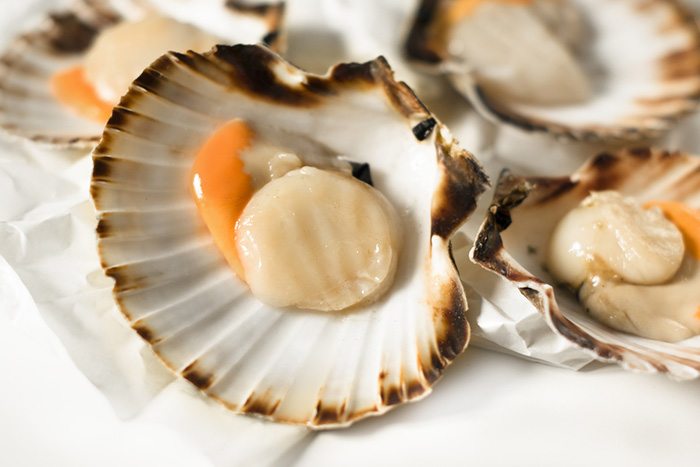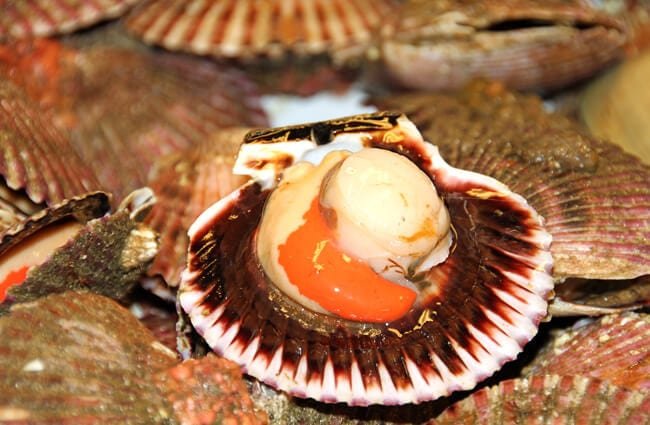Artists and craftsmen have always liked scallop shells. The shells are symmetrical and attractive, the archetypical fan-shaped shell that we sometimes see used for sinks and soap dishes in the bathroom. The living scallop is classified as a marine bivalve mollusk (like clams and oysters), from the family Pectinidae, and it is found in every ocean in the world.
Table of Contents
Plankton
Scallops have up to one hundred simple eyes that see light and dark passing by. This alerts scallops to danger as well as assists scallops in grabbing food. sea Scallops eat plankton, but the term “plankton” refers to a lot of different things. The Greek word “plankton” just refers to anything that drifts. Plankton means food that drifts through the water. That includes krill, microorganisms, algae, flagellate, and larvae, including scallop larvae. The scallops use built-in siphons to pull water over mucus membranes that trap the plankton and then hair-like cilia transfer the trapped food into the scallop’s mouth.
Scallop Habits and Habitats
If there is one thing scallop habitats have in common around the world it is vegetation. Scallops like seagrasses. The various species of scallop are adapted to different temperatures and light conditions, and the majority of scallop species are capable of rapid locomotion, so they can migrate to remain in temperatures that are most habitable. Seagrasses in mild currents both protect fertilized eggs and larva and provide adequate distribution of the eggs and larvae to ensure species survival.
Scallops Worldwide
Species of scallop can be found in almost any temperate or tropical ocean. The Icelandic scallop can even be found in sub-arctic conditions. The most numerous scallop species are found in the Atlantic Ocean, especially along with the Eastern United States and Canada. Other large scallop fisheries are found in the Sea of Japan and off the coasts of Peru and Chile in the Pacific Ocean. Ireland and New Zealand also have significant scallop fishing industries. China produces large quantities of scallops but uses mostly aquaculture, which is not a natural scallop habitat, but scallop farms.
Shrinking Habitat

Scallops are very popular seafood. Unfortunately, the demand for scallops has led to worldwide overfishing. Many scallop fisheries have collapsed in recent decades leading up to 2011 and many more are threatened. Bottom trawling, a method of catching scallops, has created the greatest stress on scallop fisheries. Fishermen drag large trawl-nets across the bottom of the ocean floor, scooping everything in their paths. Scalloping in this way not only takes away large numbers of scallops, reducing the breeding population, but it also destroys the habitats. Another cause of scallop depopulation has been the overfishing of sharks. Sharks prey on mantas, which prey on scallops. With fewer sharks, more mantas remain to prey on more scallops.
Seared scallops & creamy mash
“Juicy pan-seared scallops and salty, crisp bacon – this recipe is the perfect surf and turf marriage. ”
Method
- Juicy pan-seared scallops and salty, crisp bacon – this recipe is the perfect surf and turf marriage.
- Quarter the potatoes, halving any smaller ones, then place in a large pan and cover with cold salted water. Place over a high heat and bring to the boil, then cook for 15 to 20 minutes, or until tender.
- Meanwhile, using a sharp knife, roughly chop the bacon into chunky lardons, roughly ½cm thick. Score the scallops in a criss-cross fashion about 1cm deep on one side, season with a pinch of salt, then set aside.
- Drain and allow the potatoes to steam dry, then return to the empty pan with the milk, a knob of butter and a pinch of salt and pepper. Mash until smooth, then cover until needed.
- Heat a splash of olive oil in a large non-stick frying pan over a medium heat, then add the bacon and fry for around 2 minutes, or until golden. Move the bacon to one side of the pan, then pick the sage leaves into the space. Cook for 1 minute, or until crisp, then move to the side of the pan along with the bacon. Add the remaining butter and the scallops, cut-side down, to the empty space. Cook for around 2 minutes, or until golden, turning halfway.
- Remove from the heat, add a squeeze of lemon juice and toss to coat, allowing the scallops to cook in the hot pan for a further 30 seconds. Divide the creamy mash between plates, then spoon over the scallops, bacon, sage, and any lovely juices from the pan, then tuck in.

